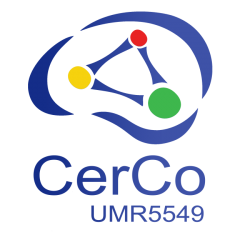Head: Benoit COTTEREAU & Jean-Baptiste DURAND
The SV3M team brings together researchers and clinicians with complementary expertise who aim at better understanding the neural and cognitive mechanisms underlying spatial vision. Together, they have developed an innovative approach which is resolutely multi-model (healthy humans, patients, monkey and machine) and trans-disciplinary (behaviour, eye tracking, electroencephalography, cortical stimulation, functional imaging in human and non-human primates, modelling). The team’s current project explores spatial vision under naturalistic conditions, focusing on its roles in navigation (axe I), on the mechanisms by which it acquires selectivity, expertise and plasticity (axe II) and on its interactions with other cognitive functions (axe III). Additionally, these three axes feed a fourth axis of translational research with strong anchors in both clinical and technological domains.
Research Topics
I. SVN: Spatial Vision and Navigation (motion processing in realistic and dynamic environment, multi-sensory integration in realistic and dynamic environment)
2. CMSV: Computational Models of Spatial Vision (modelling selectivity and expertise in spatial vision, modelling plasticity in spatial vision)
3. SVC: Spatial Vision and Cognition (spatial & social cognition, spatial vision & culture)
4. SVTR: Spatial Vision for Translational Research (technological applications, clinical applications)
Researchers
• Robin BAURES (PU)
• Benoit COTTEREAU (DR CNRS) – co-director
• Sylvain CREMOUX (MCU)
• Jean-Baptiste DURAND (CRCN CNRS) – co-director
• Franck-Emmanuel ROUX (PUPH – Neurosurgeon)
• Alexandra SEVERAC CAUQUIL (MCU)
• Vincent SOLER (PUPH – Ophtalmologist)
• Yves TROTTER (DRE CNRS)
PhD Students
- Grégoire AUDREY
- Elise ABOU-MIRAD
- Tomas DE UDAETA
- Imène DJIDJELI
- Célia GISLOT
- Alan GUYOMARCH
- Geoffroy KEIME
- Alba LANGLADE
- Marie-Alphée LAURENT
- olène LEBLOND
- Sarah MARCHAND
- Pierre-Marie MATTA
- Célia MICHAUD
- Ulysse RANÇON
Representative publications
- Baurès, R., Fourteau, M., Thébault, S., Gazard, C., Pasquio, L., Meneghini, G., … Durand, J. B. & Roux, F. E. (2020). Time‐to‐contact perception in the brain. Journal of Neuroscience Research.
- De Castro, V., Smith, A. T., Beer, A. L., Leguen, C., Vayssière, N., Héjja-Brichard, Y., … Cottereau, B. R. & Durand, J. B. (2020). Connectivity of the Cingulate Sulcus Visual Area (CSv) in Macaque Monkeys. Cerebral Cortex.
- Héjja-Brichard, Y., Rima, S., Rapha, E., Durand, J. B., & Cottereau, B. R. (2020). Stereomotion Processing in the Nonhuman Primate Brain. Cerebral Cortex.
- Rima, S., Cottereau, B. R., Héjja-Brichard, Y., Trotter, Y., & Durand, J. B. (2020). Wide-field retinotopy reveals a new visuotopic cluster in macaque posterior parietal cortex. Brain Structure and Function, 225(8), 2447-2461.
- Bogdanova, O. V., Bogdanov, V. B., Durand, J. B., Trotter, Y., & Cottereau, B. R. (2020). Dynamics of the straight-ahead preference in human visual cortex. Brain Structure and Function, 225(1), 173-186.
- Maniglia, M., Soler, V., & Trotter, Y. (2020). Combining fixation and lateral masking training enhances perceptual learning effects in patients with macular degeneration. Journal of Vision, 20(10), 19-19.
- Roux, F. E., Niare, M., Charni, S., Giussani, C., & Durand, J. B. (2020). Functional architecture of the motor homunculus detected by electrostimulation. The Journal of Physiology.
- Aedo-Jury, F., Cottereau, B. R., Celebrini, S., & Séverac Cauquil, A. (2020). Antero-Posterior vs. Lateral Vestibular Input Processing in Human Visual Cortex. Frontiers in integrative neuroscience, 14, 43.
- Contemori, G., Trotter, Y., Cottereau, B. R., & Maniglia, M. (2019). tRNS boosts perceptual learning in peripheral vision. Neuropsychologia, 125, 129-136.
- Caffier, D., Luyat, M., Crémoux, S., Gillet, C., Ido, G., Barbier, F., & Naveteur, J. (2019). Do older people accurately estimate the length of their first step during gait initiation?. Experimental aging research, 45(4), 357-371.
- Maniglia, M., Trotter, Y., & Aedo-Jury, F. (2019). TMS reveals inhibitory extrastriate cortico-cortical feedback modulation of V1 activity in humans. Brain Structure and Function, 224(9), 3399-3408.
- Chauhan, T., Masquelier, T., Montlibert, A., & Cottereau, B. R. (2018). Emergence of binocular disparity selectivity through Hebbian learning. Journal of Neuroscience, 38(44), 9563-9578.
- Roux, F. E., Djidjeli, I., & Durand, J. B. (2018). Functional architecture of the somatosensory homunculus detected by electrostimulation. The Journal of physiology, 596(5), 941-956.
- Baurès, R., Maquestiaux, F., DeLucia, P. R., Defer, A., & Prigent, E. (2018). Availability of attention affects time-to-contact estimation. Experimental Brain Research, 236(7), 1971-1984.
- Maniglia, M., Soler, V., Cottereau, B., & Trotter, Y. (2018). Spontaneous and training-induced cortical plasticity in MD patients: Hints from lateral masking. Scientific reports, 8(1), 1-11.
- Baurès, R., Balestra, M., Rosito, M., & VanRullen, R. (2018). The detrimental influence of attention on time-to-contact perception. Attention, Perception, & Psychophysics, 80(6), 1591-1598.
- Cottereau, B. R., Smith, A. T., Rima, S., Fize, D., Héjja-Brichard, Y., Renaud, L., … & Durand, J. B. (2017). Processing of egomotion-consistent optic flow in the rhesus macaque cortex. Cerebral Cortex, 27(1), 330-343.
- Séverac Cauquil, A., Ory-Magne, F., Jardiné, V., Galitzky, M., Rosito, M., Brefel-Courbon, C., & Celebrini, S. (2017). Parkinson’s patients can rely on perspective cues to perceive 3D space. Brain Research, 1663, 161-165.
- Soler, V. J., Laurent, C., Sakr, F., Regnier, A., Tricoire, C., Cases, O., … & Pagot-Mathis, V. (2017). Preliminary study of the safety and efficacy of medium-chain triglycerides for use as an intraocular tamponading agent in minipigs. Graefe’s Archive for Clinical and Experimental Ophthalmology, 255(8), 1593-1604.
- Daviaux, Y., Cremoux, S., Tallet, J., Amarantini, D., Cornu, C., & Deschamps, T. (2016). I can’t reach it! Focus on theta sensorimotor rhythm toward a better understanding of impaired action–perception coupling. Neuroscience, 339, 32-46.
- Daviaux, Y., Cremoux, S., Tallet, J., Amarantini, D., Cornu, C., & Deschamps, T. (2016). An enhanced experimental procedure to rationalize on the impairment of perception of action capabilities. Psychological research, 80(2), 224-234.
- Séverac Cauquil, A., Delaux, S., Lestringant, R., Taylor, M. J., & Trotter, Y. (2009). Neural correlates of chromostereopsis: An evoked potential study. Neuropsychologia, 47(12), 2677-2681.
